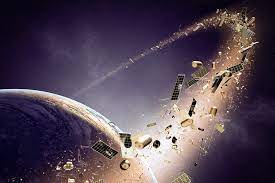What Is Space Junk?

A leftover piece of a spacecraft flying through space reportedly hit the surface of the moon, creating a new crater that may be around 65 feet wide.
- The piece of space junk was is the third-stage booster of Chang’e 5-T1 – a lunar mission launched by the China National Space Administration in 2014.
- The object reportedly weighs around four tonnes and was racing towards the moon at a speed of 9,300 km an hour.
- This is the first recorded unintentional case of space junk hitting the moon.
Project Pluto:
- American astronomer Bill Gray, who runs a blog called Project Pluto, predicted the collision by tracking the object.
- The speed, trajectory, and time of impact were calculated using earth-based telescope observations.
- Project Pluto also supplies astronomical software to amateur and professional astronomers. Gray is the creator of popular astronomy software called Guide.
- Both the earth and the moon have been hit by multiple objects like asteroids throughout their existence, but craters on the moon are of a more permanent nature than those on earth.
- This is because of processes like erosion, tectonics, and volcanism. These three processes keep the surface of the earth crater-free and remove traces of collisions that have happened in the past.
- An absence of atmosphere means there is no wind system and no weather on the moon, and hence no cause for erosion of existing craters.
- Absence of tectonics prevents the moon’s surface from forming new rocks, or causing a shift in the existing surface patterns, unlike that on earth.
- Lastly, absence of volcanism makes it impossible for craters to be covered.
- Currently, the earth has less than 200 known craters while the moon has thousands.
Space Junk:
- Space debris, also called space junk, artificial material that is orbiting Earth but is no longer functional.
- This material can be as large as a discarded rocket stage or as small as a microscopic chip of paint.
- Location: Much of the debris is in low Earth orbit, within 2,000 km of Earth’s surface, though some debris can be found in geostationary orbit 35,786 km above the Equator.
- Issue (Kessler Syndrome) : The free floating space debris is a potential hazard for operational satellites and colliding with them can leave the satellites dysfunctional.
- This is referred to as Kessler Syndrome, named after NASA scientist Donald Kessler in 1978.
- It says if there is too much space junk in orbit, it could result in a chain reaction where more and more objects will collide and create new space junk in the process, to the point where Earth’s orbit becomes unusable – a Domino Effect.
- With countries launching more and more satellites, each one of them being a strategic or commercial asset, avoiding collisions could become a challenge in the future.
- Clearspace-1 (of European Space Agency), which is scheduled to launch in 2025, will be the first space mission to eliminate debris from orbit.




